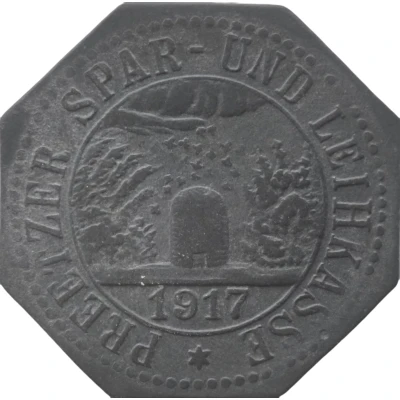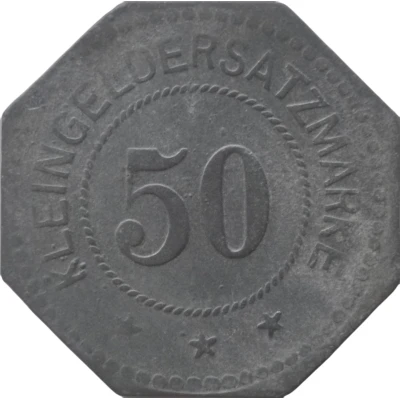


© Willem63 (CC BY-NC-SA)
50 Pfennigs - Preetz
1917 year| Zinc | 2.9 g | 24.3 mm |
| Issuer | City of Preetz (Prussian province of Schleswig-Holstein) |
|---|---|
| Issuing entity | Preetzer Spar und Leihkasse |
| Emperor | William II (Wilhelm II) (1888-1918) |
| Type | Standard circulation coin |
| Year | 1917 |
| Value | 50 Pfennigs (50 Pfennige) (0.50) |
| Currency | Mark (1914-1924) |
| Composition | Zinc |
| Weight | 2.9 g |
| Diameter | 24.3 mm |
| Thickness | 1.0 mm |
| Shape | Octagonal (8-sided) |
| Technique | Milled |
| Orientation | Medal alignment ↑↑ |
| Demonetized | Yes |
| Updated | 2024-10-04 |
| Numista | N#303904 |
|---|---|
| Rarity index | 93% |
Reverse
Pearl rim, legend surrounding rope circle with denomination centered
Script: Latin
Lettering:
KLEINGELDERSATZMARKE
50
★ ★ ★
Edge
Plain
Interesting fact
The 50 Pfennigs coin from Preetz (Prussian province of Schleswig-Holstein) made of Zinc weighing 2.9 g is interesting because it was produced during a time of economic turmoil in Germany. In 1917, the country was facing a severe shortage of coins due to the ongoing World War I, which led to the introduction of temporary substitute coins made of zinc, aluminum, and other metals. The 50 Pfennigs coin from Preetz is one such example, and it was only issued for a brief period before being replaced by a new design in 1918. Despite its short-lived circulation, the coin remains a unique and collectible piece of German numismatic history.